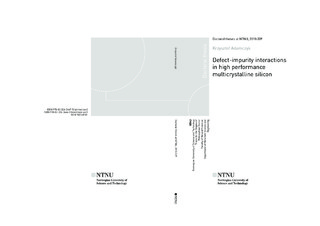| dc.contributor.advisor | Sabatino, Marisa Di | |
| dc.contributor.advisor | Stokkan, Gaute | |
| dc.contributor.advisor | Søndenå, Rune | |
| dc.contributor.author | Adamczyk, Krzysztof | |
| dc.date.accessioned | 2018-10-30T14:23:00Z | |
| dc.date.available | 2018-10-30T14:23:00Z | |
| dc.date.issued | 2018 | |
| dc.identifier.isbn | 978-82-326-3466-8 | |
| dc.identifier.issn | 1503-8181 | |
| dc.identifier.uri | http://hdl.handle.net/11250/2570217 | |
| dc.description.abstract | Defect-impurity interactions in high performance multicrystalline silicon
The global average and combined land and ocean surface temperature is steadily rising for the last several decades. About 97% of climate scientists agree this is caused by human-activity related greenhouse gas emissions. To slow down this process it is important to develop low-emission, renewable energy technologies. Photovoltaics is one group of such technologies. About 94% of the solar cells currently manufactured are made of silicon, and multicrystalline silicon takes about 70% of the total solar cell production. This is because multicrystalline silicon is cheaper to manufacture than monocrystalline, but still provides relatively high and stable module efficiencies: in the range of 16-17% of conversion efficiency. Recently one of the more significant advancements in materials engineering of photovoltaic silicon was the introduction of the so called High Performance Multicrystalline silicon (HPMC-Si). In this material the structure is controlled so that random-angle grain boundaries are present in higher densities, while in standard multicrystalline material Coincidence Site Lattice (CSL) grain boundaries dominate the structure. The random-angle grain boundaries act as sites of dislocation annihilation, leading to overall lower dislocation density, and this in turn leads to higher cell efficiencies.
Due to the nature of the technique used to grow HPMC-Si ingots, that is directional solidification, the material contains higher levels of impurities than monocrystalline silicon. With reducing the cell cost by allowing more contamination in the material, the industry is faced with the need to develop techniques mitigating the effect of lower material purity on cell performance. The aim of this thesis was to provide more insight into the interactions between extended defects and impurities and aid this development. A specific aim was to study how these interactions affected solar cell performance and how their effect changed with each high-temperature process step in cell manufacturing.
To this end silicon wafers from different parts of directionally solidified ingots were processed into cells and studied at different steps in the process. Their electrical performance was evaluated by means of minority carrier lifetime and light-beam induced current measurements. These results were compared with microstructural information from electron backscatter diffraction and microscope analysis after selective etching. Chemical composition of the material was also assessed by secondary ion mass spectroscopy, X-ray fluorescence and neutron activation analysis. Dislocation recombination strength was modelled basing on this data, and the recombination activity of different types of grain boundaries was also evaluated.
The results of this work show that dislocation recombination strength increases during phosphorus gettering. Grain boundaries, in particular random-angle grain boundaries in the middle part of the ingot, are also activated during this process. Subsequent hydrogenation of the defects during contact firing reduces the recombination activity back to pre-gettering levels. One of the main findings is that the random-angle grain boundaries are relatively well passivated after full processing, and the majority of recombination active defects are dislocation clusters and small-angle grain boundaries, which can be modelled as dislocation networks. The chemical composition analysis performed for the material at various processing steps shows that the evolution of recombination activity at defects can be correlated with changes in impurity levels due to thermal treatments. | nb_NO |
| dc.language.iso | eng | nb_NO |
| dc.publisher | NTNU | nb_NO |
| dc.relation.ispartofseries | Doctoral theses at NTNU;2018:339 | |
| dc.relation.haspart | Paper 1: Adamczyk, Krzysztof; Søndenå, Rune; M'hamdi, Mohammed; Autruffe, Antoine; Stokkan, Gaute; Di Sabatino, Marisa. Grain boundary effect on lifetime in high performance multicrystalline silicon during solar cell processing. Physica Status Solidi. C, Current topics in solid state physics 2016 ;Volum 13.(10-12) s. 812-815
https://doi.org/10.1002/pssc.201600059
Copyright © John Wiley & Sons, Inc. All rights reserved | nb_NO |
| dc.relation.haspart | Paper 2: Wiig, Marie Syre; Adamczyk, Krzysztof; Haug, Halvard; Ekstrøm, Kai Erik; Søndenå, Rune. The effect of phosphorus diffusion gettering on recombination at grain boundaries in HPMC-silicon wafers. Energy Procedia 2016 ;Volum 92. s. 886-895
https://doi.org/10.1016/j.egypro.2016.07.098
Under a Creative Commons license (CC BY-NC-ND 4.0) | nb_NO |
| dc.relation.haspart | Paper 3: Adamczyk, Krzysztof Jan; Søndenå, Rune; You, Chang Chuan; Stokkan, Gaute; Lindroos, Jeanette; Rinio, Markus; Di Sabatino Lundberg, Marisa. Recombination strength of dislocations in high-performance multicrystalline/quasi-mono hybrid wafers during solar cell processing. Physica Status Solidi (a) applications and materials science 2017 ;Volum 215.(2)
https://doi.org/10.1002/pssa.201700493
Copyright © John Wiley & Sons, Inc. All rights reserved | nb_NO |
| dc.relation.haspart | Paper 4: Adamczyk, Krzysztof Jan; Søndenå, Rune; Stokkan, Gaute; Looney, Erin; Jensen, Mallory; Lai, Barry; Rinio, Markus; Di Sabatino Lundberg, Marisa. Recombination activity of grain boundaries in high-performance multicrystalline Si during solar cell processing. Journal of Applied Physics 2018 ;Volum 123.(5) s. 1-7
https://doi.org/10.1063/1.5018797
Published by AIP Publishing | nb_NO |
| dc.relation.haspart | Paper 5: Adamczyk, Krzysztof Jan; Stokkan, Gaute; Di Sabatino Lundberg, Marisa. Guidelines for establishing an etching procedure for dislocation density measurements on multicrystalline silicon samples. MethodsX 2018 ;Volum 5. s. 1178-1186
https://doi.org/10.1016/j.mex.2018.09.013
This is an open access article under the CC BY license | nb_NO |
| dc.title | Defect-impurity interactions in high performance multicrystalline silicon | nb_NO |
| dc.type | Doctoral thesis | nb_NO |
| dc.subject.nsi | VDP::Technology: 500::Materials science and engineering: 520 | nb_NO |
